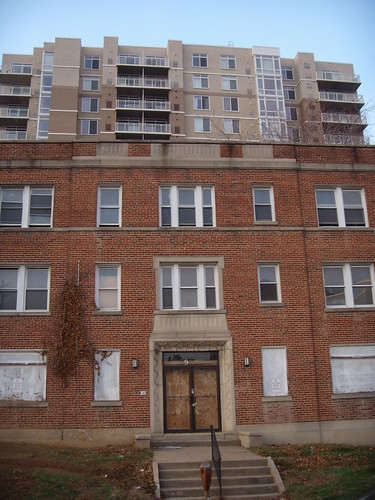 Check out this slideshow of the old and new in Downtown Silver Spring, taken on the Friday before Christmas.
Check out this slideshow of the old and new in Downtown Silver Spring, taken on the Friday before Christmas.Thayer Avenue reported earlier this week that a row of buildings at Bonifant and Fenton were demolished to make way for the new Silver Spring Library, which is planned to open in 2010. Many on the listservs have been mourning the loss of the Bonifant Courts apartments (left), which were built in 1937 and was once featured in "Best Addresses: A Century of Washington’s Distinguished Apartment Houses," as stated by Jerry McCoy from the Silver Spring Historical Society in a listserv entry.
Few would dispute that the new library - which may include shops, affordable housing and a potential Purple Line stop - will be a boon for the community. But like many revitalization projects, it comes at a price. manypeople like to call Downtown Silver Spring (the shopping complex, but sometimes the CBD as a whole) "fake" and "pre-fab." I even got into a little tiff with David Daddio from Rethink College Park last week for calling DTSS "as organic as a Twinkie." Tearing out the independent businesses and historic buildings that lined this stretch of Bonifant Street only adds fuel to the argument that the Downtown looks "inauthentic." (Inviting a multi-national corporation to open a facsimile of a famous San Francisco music hall doesn't help, either, but that's for another day.)
All great cities look as if they were built over time - because they were. There have been three bursts of development in Silver Spring: "garden apartments" and the eponymous Silver Spring Shopping Center in the 1930's and 40's; office towers and parking garages in the 1960's and 70's, and the current revitalization that began in the 1990's. Each period of growth added a new layer onto the place that already existed, making it more interesting and more complex.
I, for one, do not want to live in a place that looks like it was built all at once - neither a Silver Spring frozen in 1938 nor one straight out of 2008 - because neither is authentic. Downtown Silver Spring will never be considered a "real" place until we have a stronger push for historic preservation. And the historic preservation lobby in Silver Spring will never be taken seriously unless it actively considers opportunities for adaptation and re-use: how could our older buildings be incorporated into the "new" Silver Spring?
We want to bury Silver Spring's past because of its reputation for crime and decay, but in doing so, our generation may leave an even worse legacy. For better or for worse, Bonifant Courts may be gone - but there are still other buildings to save, if only to keep the haters quiet.

7 comments:
Dan,
Correction is in order. I have never said, in print or otherwise, that Bonifant Court was featured in “Washington’s Great Addresses” (perhaps you meant to say “Best Addresses: A Century of Washington’s Distinguished Apartment Houses,” by James M. Goode?)
And you comment, “…the historic preservation lobby in Silver Spring will never be taken seriously unless it actively considers opportunities for adaptation and re-use: how could our older buildings be incorporated into the "new" Silver Spring?” Assuming you mean the Silver Spring Historical Society when you say “historic preservation lobby,” SSHS has ALWAYS advocated adaptive reuse of older structures.
Examples are the 1945 Baltimore & Ohio Railroad Station, now leased to a non-profit; the 1935 American Instrument Co., now Mayorga; the 1927 National Institute of Dyers and Cleaners, undergoing transformation to apartments; the 1946 Canada Dry Bottling Plant, lobby incorporated into entrance of the Silverton Condos; 1915 original Silver Spring Armory/Fire Station, to become Hook and Ladder Brewery.
Shall I name more?
What about the bungalows on Thayer Avenue? The Watson House in Woodside? All I've heard (from SSHS or anyone else) is that these buildings should be kept as-is rather than be incorporated into something else.
Don't be so combative, Jerry. We're on the same page here.
We are?
Concerning the Watson house in Woodside Forest, it is in middle of a residential neighborhood. It could not be adapted for reuse for any other purpose and conform with the existing residential zoning -- or are you proposing that something commercial should be put in the middle of a single family residential neighborhood? The only alternative, as proposed, is to destroy the best example of a pre-suburban development Dutch Colonial home in the county and cut up its lot to put in 5 new houses, which, undoubtely, will not be moderately priced.
``the best example of a pre-suburban development Dutch Colonial home in the county''
How I have longed to find ``the best example of a pre-suburban development Dutch Colonial homein the county.'' Thank you for telling me about it so that I may show this precious gem to my children.
It is very unfortunate that the good work that is done by the many people at SSHS is often overshadowed by the confrontational and abrasive personality of Jerry McCoy. I was a member of the SSHS, and I still believe in preserving the character of SS, but I grew so tired of Jerry's demeanor being the face of SSHS that I tore up my membership renewal. Yes, SHSS needs a strong leader, but that doesn't mean they have to attack everyone, even people who are on the same page. Just because you lead a cause doesn't mean you have to be caustic.
Thanks for a thought-provoking article about Silver Spring
Post a Comment